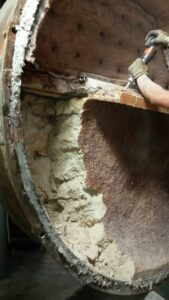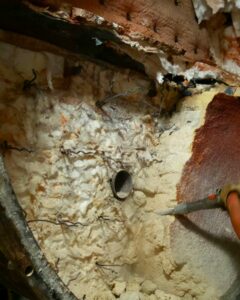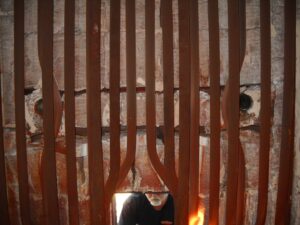Boiler refractory issues are one of the leading causes of boiler shutdowns and also the easiest to go undetected. In this article we cover the basics of boiler refractory repair and what to watch out for.
What is Refractory?
Boiler refractory is heat-resistant materials that are used to line the boiler to help it retain heat. This prevents thermal loss during boiler operation. It also helps the boiler retain heat even when it is not firing.
Refractory can be made of a number of different materials but is commonly brick, tile, castables or gunning mixes.
According to American Boiler Company, boiler refractory can be comprised of:
“…compounds and minerals such as fireclays, bauxite, silicon carbide, zirconia, chromite, alumina, dolomite, or magnesite.”
Regardless of the material being used, it extremely important that it is able to withstand the heat, pressure and chemicals used in a boiler. If the incorrect refractory material is used, it can create serious safety issues that will also result in boiler downtime.
Note: Refractory is used in heating applications of 1000 degrees Fahrenheit or more.


Boiler Door Refractory Removal
What Causes Refractory Failure?
While refractory tends to be resilient in nature, it is in fact considered a consumable. This means general wear and tear over time will eventually cause it to fail. This is due to the high pressures, high temperatures, slag and chemicals in a boiler system.
One of the most common causes of refractory failure, outside general wear and tear, is spalling. This is when the refractory materials expand or contract at different rates due to thermal conditions. This often results in cracks in the refractory that require repair.
Finally, if the incorrect refractory materials are installed, it will eventually lead to failure. When this occurs, the refractory is often unable to handle the pressure or heat and begins to crack or crumble.
Signs Of Failure


Boiler Door Refractory Removal
According to Honiron, “Common signs that the refractory material of your boiler may need repair include fractured or broken refractory tiles. You may also see evidence of boiler leaks, difficulty in opening and closing refractory doors, and damaged seal joints.”
Another common sign of failure is the appearance of hot spots on the casing, burner area, or shell of the boiler. This is when one spot on a boiler is hotter than the surrounding area, indicating damage to the refractory in that area. Common tell-tale signs are burnt paint in an area or budging in an area.
Boiler Refractory Repair Basics
Before we get into how to repair refractory cracks, it is important to realize that not all cracks are bad. In fact, some cracks are normal. The normal cracks are small and close up during the heating process and open again during the cooling process. This is due to thermal expansion and contraction. If these cracks get filled while the refractory is cool, they shell will bulge when the refractory expands during the heating process.

A good rule of thumb is that if the crack or section missing is larger than a fist, you should call a refractory expert. If it is smaller, and you wish to repair the crack yourself, follow these steps:
Begin by cleaning the surface of the refractory of any loose material with the goal of “V”ing out the crack. Once complete, you can apply the appropriate refractory repair compound to the crack. This often requires the crack be at least 5 mm in size. Work the compound into the crack and finally smooth it out.


Failing Refractory Inside The Boiler
Need Boiler Refractory Repair Help?
Have questions about repairing your system or need help from the pro’s? Call us at 1-800-237-3141, email sales@rasmech.com, chat with a support agent, or contact us online.
You can also reach out to one of our offices in Omaha, Council Bluffs, Denver, Sioux City, Sturgis, Gibbon or Lincoln.


